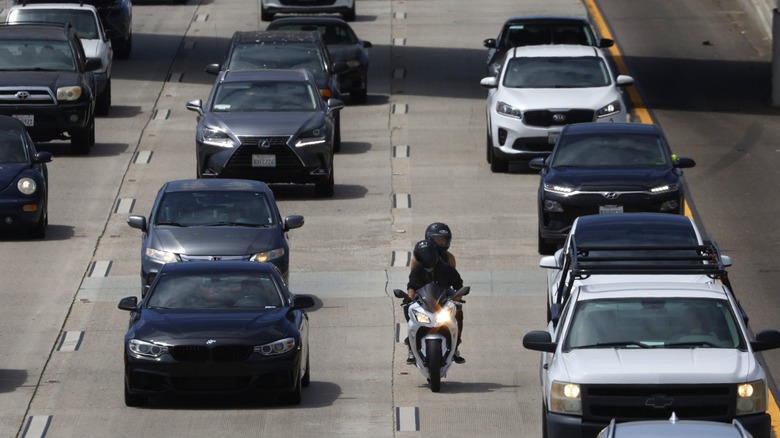Motorcycle Lane Splitting Vs. Lane Filtering: What's The Difference?
Motorcycles are appealing for numerous reasons. Not only can they be exceptionally fuel-efficient compared to a car, but they can also be a really fun way to zip around town. Motorcycles' small sizes make them highly agile, especially in a dense, urban environment with lots of traffic. However, that same agility and versatility that so many motorcycle enthusiasts prize can also be a source of contention among other motorists and road users.
Many drivers of cars and other large vehicles dislike the way motorcyclists are able to exploit the diminutive size of their bikes. That holds especially true when it comes to certain driving activities, like weaving in and out of traffic, either to get to the front of an intersection or simply navigate a busy highway. While this type of behavior may be aggravating to some, others believe it to be extremely dangerous, not only for the motorcyclist, but for everyone else on the road.
The general term for that type of motorcycle driving is lane splitting. However, the phrase often functions as sort of a catch-all for a couple of similar types of motorcycle riding, including lane filtering. There are a few differences between lane splitting and lane filtering, and it's important to understand these distinctions, depending on the laws in your area. Fortunately, that's what we're going to cover together. Here's the difference between motorcycle lane splitting and lane filtering, and whether the behavior is actually as dangerous as many contend.
What is motorcycle lane splitting?
Officially, lane splitting refers to a motorcyclist riding in between two lanes of traffic moving in the same direction. Lane splitting can occur on a road or highway with more than two lanes of traffic, and the traffic can be moving quickly or slowly. The defining characteristic is the rider's navigating in between two parallel lanes at a time. Because of this, lane splitting is sometimes called white lining or stripe riding, thanks to the motorcyclist's position on the dividing lines between traffic.
Lane splitting is a quick and useful way for motorcyclists to get around slower moving traffic, and it's a commonly-seen tactic in cities and other densely-populated areas. However, many people dislike this behavior and consider it dangerous. The reality, though, is that lane splitting can be beneficial in numerous ways. Regarding safety, lane splitting can actually help prevent accidents — by moving quickly to the front of the line, motorcyclists can reduce their chances of being rear-ended by a careless driver. Furthermore, many believe that lane splitting can help reduce traffic congestion, as riders take up less space at intersections and leave the road more quickly. Finally, lane splitting can also contribute to reduced emissions since motorcyclists will spend less time idling at intersections or moving slowly behind traffic.
All that said, lane splitting can still be dangerous, especially for novice motorcycle riders. Additionally, the act is illegal in most of the United States. California does allow lane splitting to some degree, but it's a big no-no in most of the country. It's important that you check your local laws regarding lane splitting, as the penalties for getting caught can be steep.
What is motorcycle lane filtering?
In comparison to lane splitting, which can occur at any speed, lane filtering generally refers to a motorcyclist riding between two slow or stopped lanes of traffic, like at a redlight intersection. As with lane splitting, lane filtering allows riders to quickly get around slow or stopped traffic, and it offers many of the same benefits described above. However, while both types of riding involve the driver moving between parallel lanes of traffic, lane filtering is typically more accepted, and it's important to note the distinction between the two practices, due to the difference in laws surrounding them.
We mentioned that lane splitting is illegal in most of the United States. Lane filtering, on the other hand, is legal, to some degree, in many parts of the country. It's important to note that different states can have different definitions of what lane filtering is. For example, Colorado considers lane splitting to be the act of driving between two lanes of traffic, regardless of whether the vehicles are moving or stationary, and the state outlaws this behavior. It does allow a form of lane filtering, though, which Colorado defines as a motorcyclist passing a completely stopped vehicle in the same lane. That means that Colorado riders can use this technique at red lights and other intersections, but they must avoid crossing or straddling the line between traffic, which may be difficult, depending on the size of the other vehicles at the intersection.
In addition to always following motorcycle safety tips, it's vital that you look into local laws in your area if you plan to engage in any form of lane filtering or lane splitting. As mentioned, the penalties can be harsh if you get caught riding this way in an illegal area.


